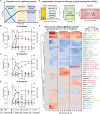Revealing systematic changes in the transcriptome during the transition from exponential growth to stationary phase
- PMID: 39714213
- PMCID: PMC11748552
- DOI: 10.1128/msystems.01315-24
Revealing systematic changes in the transcriptome during the transition from exponential growth to stationary phase
Abstract
The composition of bacterial transcriptomes is determined by the transcriptional regulatory network (TRN). The TRN regulates the transition from one physiological state to another. Here, we use independent component analysis to monitor the composition of the transcriptome during the transition from the exponential growth phase to the stationary phase. With Escherichia coli K-12 MG1655 as a model strain, we trigger the transition using carbon, nitrogen, and sulfur starvation. We find that (i) the transition to the stationary phase accompanies common transcriptome changes, including increased stringent responses and reduced production of cellular building blocks and energy regardless of the limiting element; (ii) condition-specific changes are strongly associated with transcriptional regulators (e.g., Crp, NtrC, CysB, Cbl) responsible for metabolizing the limiting element; and (iii) the shortage of each limiting element differentially affects the production of amino acids and extracellular polymers. This study demonstrates how the combination of genome-scale datasets and new data analytics reveals the fundamental characteristics of a key transition in the life cycle of bacteria.
Importance: Nutrient limitations are critical environmental perturbations in bacterial physiology. Despite its importance, a detailed understanding of how bacterial transcriptomes are adjusted has been limited. By utilizing independent component analysis (ICA) to decompose transcriptome data, this study reveals key regulatory events that enable bacteria to adapt to nutrient limitations. The findings not only highlight common responses, such as the stringent response, but also condition-specific regulatory shifts associated with carbon, nitrogen, and sulfur starvation. The insights gained from this work advance our knowledge of bacterial physiology, gene regulation, and metabolic adaptation.
Keywords: RNA-sequencing; independent component analysis; nutrient starvation; stationary phase; stress; systems biology; transcriptome.
Conflict of interest statement
The authors declare no conflict of interest.
Figures





References
-
- Lim HG, Rychel K, Sastry AV, Bentley GJ, Mueller J, Schindel HS, Larsen PE, Laible PD, Guss AM, Niu W, Johnson CW, Beckham GT, Feist AM, Palsson BO. 2022. Machine-learning from Pseudomonas putida KT2440 transcriptomes reveals its transcriptional regulatory network. Metab Eng 72:297–310. doi:10.1016/j.ymben.2022.04.004 - DOI - PubMed
MeSH terms
Substances
Grants and funding
LinkOut - more resources
Full Text Sources
Research Materials
Miscellaneous
